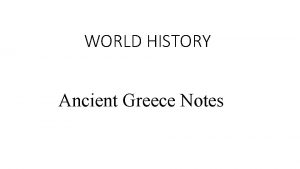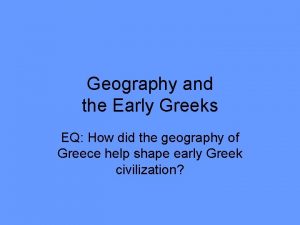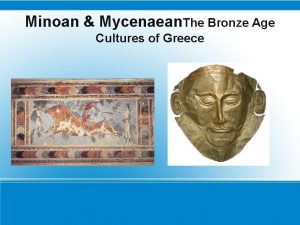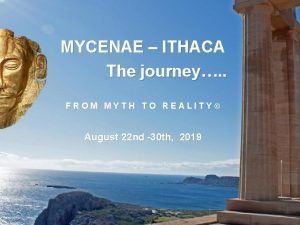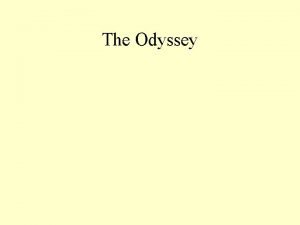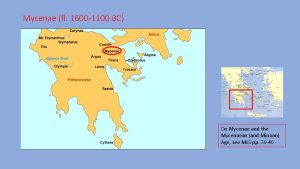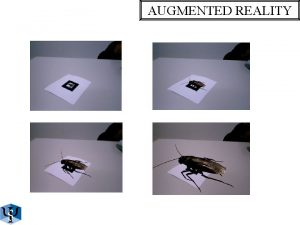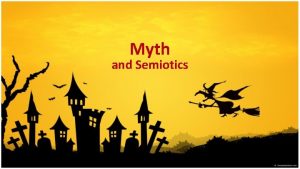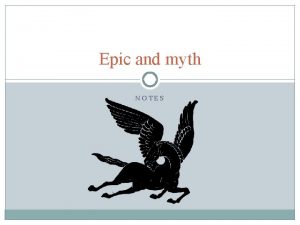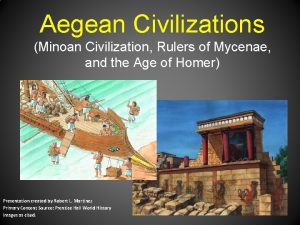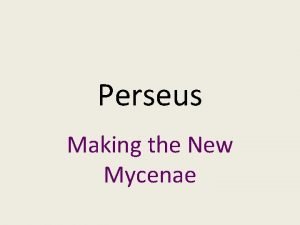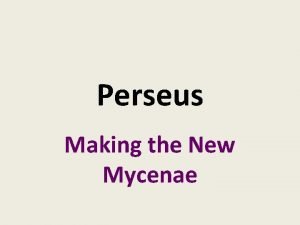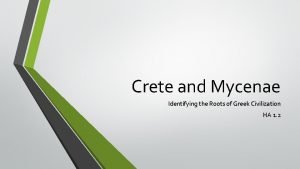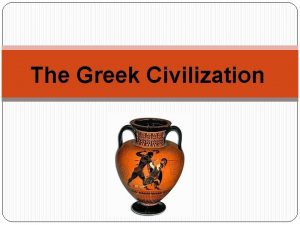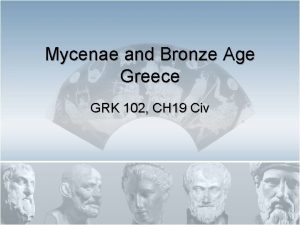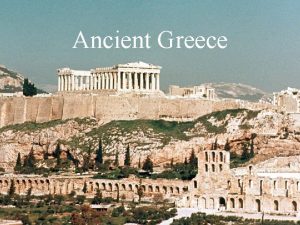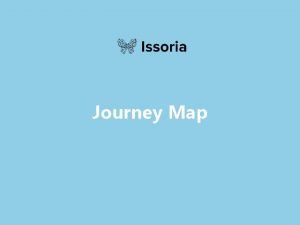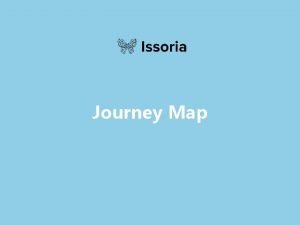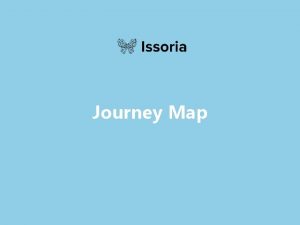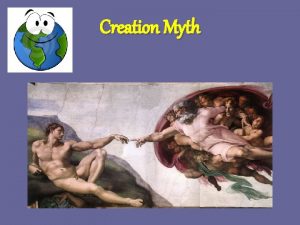MYCENAE ITHACA The journey FROM MYTH TO REALITY



























- Slides: 27

MYCENAE – ITHACA The journey…. . FROM MYTH TO REALITY© August 22 nd -30 th, 2019

T H E J O U R N E Y……. . Your path of 9 amazing days! T H E J O U R N E Y……. . Ithaca Eleusis Kyllini or Patras Mycenae Olympia Nafplio Epidaurus Athens

W E L C O M E S S A G E WELCOME TO THE JOURNEY……. Καλώς ήρθατε «KALOS IRTHATE» Warmest greetings from Greece! We invite you to take the journey with us from Athens, through the Peloponnese and on to Ithaca. . Why Greece? Greece is the birthplace of the Olympic games, and many modern ideas relating to philosophy, medicine, architecture, the arts and democracy. Greece is also the meeting point between the East and the West. The contribution of the values of the Hellenic civilisation to the foundation and promotion of the European and global civilisation, is very important, not only for historical reasons, but also as a present day claim for healthier societies in having balanced, integrated, free and responsible people. Interested individuals, students, self and world explorers are all invited to make this a truly global experience in a delightful program! You will get the unique opportunity to interact with the local community and experience the collective life style which reflects the timeless essence of Greece. We look forward to traveling with you! Barbara Kondilis, Coordinator for the summer abroad program “The journey…. . from myth to reality”

M I S S I O N The program “MYCENAE-ITHACA …. the journey, from Myth to Reality” © is designed and offered by the Center of European Studies and Humanities “Ioannis Kapodistrias”/ “Centre of Mycenaean Studies” and the Argolis club for UNESCO. “MYCENAE-ITHACA …. the journey, from Myth to Reality”, will start from Athens and has as final destination the mythical island of Ithaca in the Ionian sea, the land of Odysseus. It is a program specifically created by the Centre of Mycenaean Studies to emphasize the history and cultural heritage and the influence it has on politics, art, culture, music, religion, mythology and society at large throughout the centuries…. Moreover, the cumulative experience aspires to impart valuable information, by leading our guests back in time while simultaneously visiting the charming villages and the magnificent countryside of the Peloponnese and the island of Ithaca. This collaborative hospitality (φιλοξενία «filoxenia» ) will remain for ever an integral component of our soul (ψυχή «psyche» ).

W H O W E A R E Mary Marouli-Zilemenou, Ph. D. , Professor Comparative Politics, Hellenic National Council of Clubs & Centers for UNESCO, President, Argolis Club for UNESCO, President Ximena Ponce de Leon, Ph. D. Professor, University of San Diago, Chile Barbara Kondilis, MSW, MPH, Counselor & Public Health Specialist, Assistant Professor, Hellenic American College/ Hellenic American University Isaia Tsaousidou, Journalist, Association of European Journalistes, Vice President Spyridon Ntouras, Student of Social Sciences, Panteion University, Athens

PROGRAM COORDINATORS & ADMINISTRATIVE SUPP ORT Barbara Kondilis, Coordinator of the summer program in Greece, Educator TBA -- Coordinator of archaeological & historical sites Administrative support Michalis Michalopoulos, Assistant

T H E J O U R N E Y……. . Ithaca Eleusis Kyllini or Patras Mycenae Olympia Nafplio Epidaurus Athens

T H E P R O G R A M 1 st & 2 nd Day Arrival to Athens is the capital of Greece and took its name from Athena, goddess of wisdom. Athens is one of the world’s oldest cities, with its recorded history spanning approximately 3, 400 years. Ancient Athens was a powerful city-state and the place where democracy, philosophy, literature, medicine, science, the arts and architecture were born. The brilliance of this city has ongoing cultural and political impact on European and Western Civilization. The Herodus Atticus Theatre It was built in 161 AD by Herodus Atticus in memory of his wife. It is used as a venue for cultural performances with a seating capacity for 5, 000 persons. The Plaka area – Athens © www. bestofathens. gr

The Parthenon, the Acropolis Museum, the Athenian Agora 1 st & 2 nd Day The Parthenon is the most important surviving building of classical Greece, generally considered the zenith of the Doric order. Its decorative sculptures are considered some of the high points of Greek art. The Parthenon is regarded as an enduring symbol of Ancient Greece, Athenian democracy, and western civilization; one of the world's greatest cultural monuments. Watch the Opening Ceremony of the New Acropolis Museum, directed by Athina Rachel Tsangari on the link below: https: //www. youtube. com/ watch? v=Ia. Gd. Jrb. OKes © Christina Mastoraki © Vasiliki Eleni Dimitriou Ancient Agora The Agora was the heart of ancient Athens, the focus of political, commercial, administrative and social activity, the religious and cultural center, and the seat of justice. © Dr Mary Marouli - Zilemenou

Athens - Eleusis (Elefsina) 3 rd Day Eleusis (or Elefsina) is situated about 18 km northwest from the center of Athens. It is best known for having been the site of the Eleusinian Mysteries -- one of the most famous religious events of the ancient Greek religion. It is also the birthplace of Aeschylus, one of the three great tragedians of antiquity. Ancient area of Eleusis © Wikipedia

Asine, Epidaurus, Asklepion & the Theater 3 rd & 4 th Days Asine was mentioned by Homer as part of the kingdom of Diomedes, king of Argos. The acropolis of ancient Asine was surrounded by a Cyclopean wall and a Mycenaean era necropolis with many Mycenaean chamber tombs. Asclepius Epidaurus, known for its sanctuary and its theater, was the birthplace of Asclepius the healer, son of god Apollo. Theater was famous for its symmetry, acoustics, locale and is still a major site utilized today for dramatic performances. Asclepion of Epidaurus, the most important in the ancient world. © Wikipedia

Nafplio - Bourtzi - Palamidi 4 th & 5 th Days Nafplio was the first capital of modern Greece after the independence from the Turks in 1828. The city was taken in 1212 by the French crusaders of the Principality of Achaea. It became part of the lordship of Argos and Nauplia, which in 1388 was sold to the Republic of Venice (Italy). On the 8 th January 1828 the first governor of Greece, Ioannis Capodistrias, alighted at Nafplio. The city was full of cafes, and in the salons of notable local families there were balls and literary soirees. A printing press was established and for a short while there was a reading room. Source: www. nafplio. gr

Nafplio - Bourtzi - Palamidi The Palamidi fortress was built on a hill by the Venetians during their occupation of the area between the years 1686 and 1715. Built as a typical baroque style fortress of stone, for one to reach the top there are 999 steps. The small island of Bourtzi in Nafplion is famous for its strong and impressive fortress. Still known by its Turkish name “Bourtzi”, meaning the Tower, it attracts many visitors all year round. Antonio Gambello, an architect from Bergamo, built the castle in 1471 on this tiny islet in front of the port of Nafplion. In 1935 it was turned into a hotel after alterations by the German architect Wulf Schaeffer. Today one can visit the Bourtzi by boat from the seafront.

Nafplio Views of the picturesque city of Nafplio Source: www. nafplio. gr

Mycenae, Tiryns , Medea 5 th Day Mycenae, one of the major centers of Greek Civilization and of the Mycenaean World, was an acropolis site and a military stronghold which dominated southern Greece. Mycenae, Lion Gate There are several unique archaeological findings that prove the cultural advancement of the ancient Mycenaean civilization. The Mask of Agamemnon © www. taxi-nafplio. gr Tiryns was a hill fort and one of the most important centers of the Mycenaean World. Mycenaean ring by Mary Papakonstantinou, especially designed and offered to the Center of Mycenaean Studies

Olympia 6 th Day Olympia. The most important and well-known sanctuary of ancient Greece. It was dedicated to Zeus, father of the 12 gods. It is one of the main monuments of cultural heritage of UNESCO. The Olympic Flame ceremony Archaeological Site of Olympia (Greece) © UNESCO

Ithaca 7 th & 8 th Day The journey …… to Ithaca Excerpts from C. P. Cavafy’s poem “Ithaka” © 1910 (translation by Edmund Keely and Philip Sherrard)) As you set out for Ithaca hope that your journey is a long one, full of adventure, full of discovery. Laistrygonians and Cyclops, angry Poseidon—don’t be afraid of them: you’ll never find things like that on your way as long as you keep your thoughts raised high, as long as a rare excitement stirs your spirit and your body. Laistrygonians and Cyclops, wild Poseidon—you won’t encounter them unless you bring them along inside your soul, unless your soul sets them up in front of you. Hope the voyage is a long one. May there be many a summer morning when, with what pleasure, what joy, you come into harbors seen for the first time; may you stop at Phoenician trading stations to buy fine things, mother of pearl and coral, amber and ebony, sensual perfume of every kind— as many sensual perfumes as you can; and may you visit many Egyptian cities to gather stores of knowledge from their scholars. Keep Ithaca always in your mind. Arriving there is what you're destined for. But don't hurry the journey at all. Better if it lasts for years, so that you're old by the time you reach the island, wealthy with all you've gained on the way, not expecting Ithaca to make you rich. Ithaca gave you the marvelous journey. Without her you would have not set out. She has nothing left to give you now. And if you find her poor, Ithaca won't have fooled you. Wise as you will have become, so full of experience, you'll have understood by then what these Ithacas mean. Listen to the C. P. Cavafy’s poem “Ithaca” © 1910 recited by Sean Connery and with music specially composed by Vangelis on the link below: https: //www. youtube. com/watch? v=1 n 3 n 2 Ox 4 Yfk

Ithaca 7 th & 8 th Day © Delas Photography

Ithaca 8 th Day Odysseus (Ulysses), King of Ithaca Source: http: //www. zwallpix. com/telemachus-son-ofodysseus. html The island of Ithaca has been inhabited since the 2 nd millennium BC. It may have been the capital of Cephalonia during the Mycenaean period and the capital-state of the small kingdom ruled by Odysseus. The Romans occupied the island in the 2 nd century BC, and later it became part of the Byzantine Empire. The Normans ruled Ithaca in the 13 th century, and after a short Turkish rule it fell into Venetian hands (Ionian Islands under Venetian rule). Head of Odysseus wearing a pileus depicted on a 3 rd century BC coin from Ithaca Classical Numismatic Group, Inc. Source: http: //www. cngcoinc. com

Ithaca & Side Trip (optional) 9 th Day …are you still so eager to go back to your own house and the land of your fathers? I wish you well, however you do it, but if you only knew in your own heart how many hardships you were fated to undergo before getting back to your country, you would stay here with me and be the lord of this household and be an immortal. Kalypso to Odysseus (Book 5, lines 203 -209 The Odyssey; translation Richmond Lattimore) Palace in Ithaca discovered

Ithaca’s flavors Taste the local foods © Delas Photography

Ithaca Enjoy the beautiful sunsets of Ithaca © Dr Mary Marouli – Zilemenou © Delas Photography

Ithaca © Delas Photography

Ithaca - Athens 9 th & 10 th Day Ithaca by Edward Dodwell (1821)

M A K I N G M E M O R I E S Photos with students from our past programs !

E N D O F T H E P R O G R A M Departure to “El. Venizelos” airport (or continued travel/vacation) «Δραπετεύσεις» Χρήστος Λάσκαρης “Escapes” by Christos Laskaris (1931 -2008), Greek poet No one lives without departing. And even the statues, they also depart at night. Thank you for joining us… Pleasant travels!

Address: 36 Voukourestiou Str. , 10673 Athens Telephone: +30 210 3626 316 Fax: +30 210 3626 365 E-mail: mycenaeanprogram. ithaca@gmail. com Website: www. europeanstudies. org. gr CENTER OF MYCENAEAN STUDIES UNESCO CLUB OF ARGOLIS The Center of Mycenaean Studies was founded in 2001 in order to promote the study and research of the Mycenaean civilization due to the importance of Mycenae, for understanding the Hellenic and Western Civilization as a whole. The ARGOLIS Club for UNESCO was founded in 1999 and operates successfully on projects concerning the Greek culture and implemented through educational seminars in Argolis. Greece. The Mycenaean Civilization is known as one of the most historically important cultures developed in ancient Greece. During the growth and prosperity of this civilization, many diverse backgrounds and new cultures were assimilated through trade and geographic expansion across the East, the West and the Mediterranean basin. In 2001, under the auspices of UNESCO, a pilot program was launched entitled "Lessons in Mycenaean civilization " addressed mainly to foreign students of universities from Europe and USA. It is a cycle study of Mycenaean civilization that enables young people to become acquainted with one of the greatest civilizations of the ancient world. The important centers of Mycenaean civilization, Mycenae and Tiryns, were the cultural hubs of the Minoan and the Cycladic people. In these two cities, Greek myths were born and Homer wrote his famous works the Iliad and the Odyssey (epics that influenced European art and literature for more than three millennia afterwards). There are several unique archeological findings which prove the intellectual and cultural advancement of the ancient Mycenaean civilization. Golden masks, pure gold busts (in the forms of a bull and a lion's head), perfect specimens of ivory carvings, numerous vessels, sealstones, crystals, and frescoes all show ahead of their time the Mycenaean peoples were. From these findings it was justified that the city of Mycenae was rich in artistry and gold. In the area occupied by the Mycenaean civilization ideas and physical structures were created, directly influencing modern Greece and the present-day West. Classes take place every summer in Argolis from 2001. A very important program, launched under the auspices of the Ministry of Education, involves an audio-visual spectacle (CDROM) under the title "POLYCHRYSES MYCENAE". The production is based on using three-dimensional digital computer animation at the highest available quality level "photorealism" and is intended for schools and other educational institutions in Greece and abroad.
 Zoos connect us to the natural world
Zoos connect us to the natural world Hilda tresz
Hilda tresz Map of sparta greece
Map of sparta greece Archaeological site of mycenae
Archaeological site of mycenae Myceneans
Myceneans Emulsify drupal
Emulsify drupal James j. whalen
James j. whalen Ithaca poem
Ithaca poem The odyssey cannibals
The odyssey cannibals Buddingh basket weeder
Buddingh basket weeder Các châu lục và đại dương trên thế giới
Các châu lục và đại dương trên thế giới Thế nào là hệ số cao nhất
Thế nào là hệ số cao nhất Hệ hô hấp
Hệ hô hấp Tư thế ngồi viết
Tư thế ngồi viết Cái miệng bé xinh thế chỉ nói điều hay thôi
Cái miệng bé xinh thế chỉ nói điều hay thôi Hình ảnh bộ gõ cơ thể búng tay
Hình ảnh bộ gõ cơ thể búng tay đặc điểm cơ thể của người tối cổ
đặc điểm cơ thể của người tối cổ Cách giải mật thư tọa độ
Cách giải mật thư tọa độ Tư thế worm breton là gì
Tư thế worm breton là gì Tư thế ngồi viết
Tư thế ngồi viết ưu thế lai là gì
ưu thế lai là gì Gấu đi như thế nào
Gấu đi như thế nào Thẻ vin
Thẻ vin Thơ thất ngôn tứ tuyệt đường luật
Thơ thất ngôn tứ tuyệt đường luật Các châu lục và đại dương trên thế giới
Các châu lục và đại dương trên thế giới Từ ngữ thể hiện lòng nhân hậu
Từ ngữ thể hiện lòng nhân hậu Diễn thế sinh thái là
Diễn thế sinh thái là Slidetodoc
Slidetodoc


